Water sensitivity of heteroepitaxial Cu-MOF films: dissolution and re-crystallization of 3D-oriented MOF superstructures†
Abstract
3D-oriented metal–organic framework (MOF) films and patterns have recently emerged as promising platforms for sensing and photonic applications. These oriented polycrystalline materials are typically prepared by heteroepitaxial growth from aligned inorganic nanostructures and display anisotropic functional properties, such as guest molecule alignment and polarized fluorescence. However, to identify suitable conditions for the integration of these 3D-oriented MOF superstructures into functional devices, the effect of water (gaseous and liquid) on different frameworks should be determined. We note that the hydrolytic stability of these heteroepitaxially grown MOF films is currently unexplored. In this work, we present an in-depth analysis of the structural evolution of aligned 2D and 3D Cu-based MOFs grown from Cu(OH)2 coatings. Specifically, 3D-oriented Cu2L2 and Cu2L2DABCO films (L = 1,4-benzenedicarboxylate, BDC; biphenyl-4,4-dicarboxylate, BPDC; DABCO = 1,4-diazabicyclo[2.2.2]octane) were exposed to 50% relative humidity (RH), 80% RH and liquid water. The combined use of X-ray diffraction, infrared spectroscopy, and scanning electron microscopy shows that the sensitivity towards humid environments critically depends on the presence of the DABCO pillar ligand. While oriented films of 2D MOF layers stay intact upon exposure to all levels of humidity, hydrolysis of Cu2L2DABCO is observed. In addition, we report that in environments with high water content, 3D-oriented Cu2(BDC)2DABCO recrystallizes as 3D-oriented Cu2(BDC)2. The heteroepitaxial MOF-to-MOF transformation mechanism was studied with in situ synchrotron experiments, time-resolved AFM measurements, and electron diffraction. These findings provide valuable information on the stability of oriented MOF films for their application in functional devices and highlight the potential for the fabrication of 3D-oriented superstructures via MOF-to-MOF transformations.

- This article is part of the themed collection: Celebrating the scientific accomplishments of RSC Fellows


 Please wait while we load your content...
Please wait while we load your content...